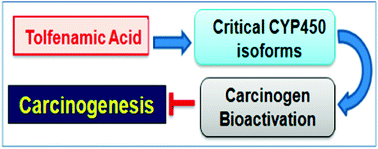Tolfenamic acid suppresses cytochrome P450 2E1 expression in mouse liver
Abstract

* Corresponding authors
a
Cancer Research Institute, MD Anderson Cancer Center Orlando, 6900 Lake Nona Blvd, Orlando, USA
E-mail:
riyaz.basha@orlandohealth.com
Fax: +1-407-266-7406
Tel: +1-407-266-7409
b
Burnett School of Biomedical Sciences, College of Medicine, University of Central Florida, 6900 Lake Nona Blvd, Room #349, Orlando, USA
E-mail:
ssiddiqi@mail.ucf.edu
Fax: +1-407-266-7002
Tel: +1-407-266-7041
c College of Medicine, Florida State University, Orlando, USA
d Department of Medical Education, College of Medicine, University of Central Florida, Orlando, USA

 Please wait while we load your content...
Something went wrong. Try again?
Please wait while we load your content...
Something went wrong. Try again?
 Fetching data from CrossRef.
Fetching data from CrossRef.
This may take some time to load.
Loading related content
